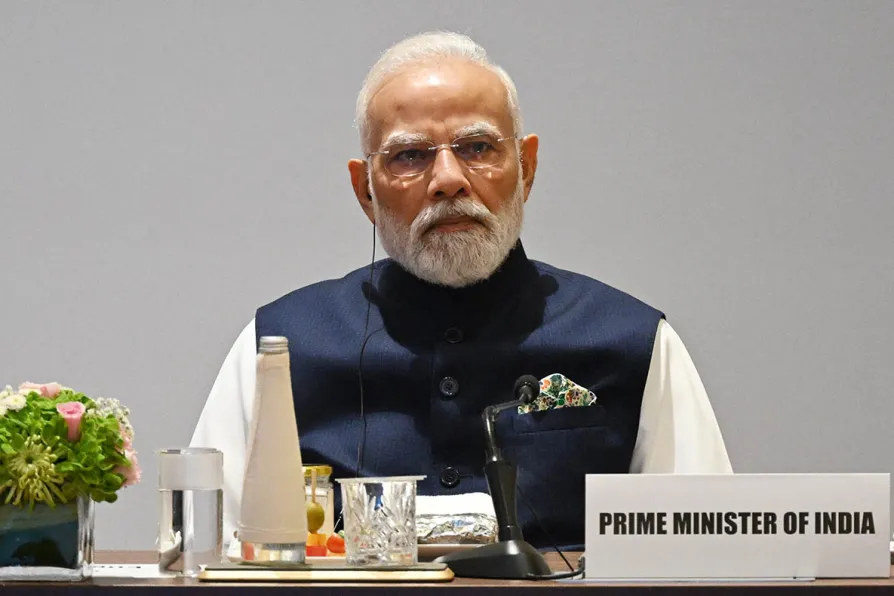Trump’s escalation against Venezuela is about more than oil, it is about regaining control over the ‘natural’ zone of influence of the United States at a moment where its hegemony is slipping, argues VIJAY PRASHAD
Modi has rolled out the carpet for the Taliban in New Delhi — and we shouldn’t be surprised. They have more in common than you might think, argues Bhabani Shankar Nayak

 Indian Prime Minister Narendra Modi attends the India-UK CEO Forum at Jio World Convention Centre in Mumbai, India, October 9, 2025
Indian Prime Minister Narendra Modi attends the India-UK CEO Forum at Jio World Convention Centre in Mumbai, India, October 9, 2025
THE Modi regime rolled out the red carpet for Taliban-appointed Afghan Foreign Minister Amir Khan Muttaqi during his visit to India. This move not only grants legitimacy to the Taliban but also undermines India’s image among the peace-loving people of Afghanistan and the world.
It weakens those who are fighting for democracy and peace against the Taliban regime. India has always stood with the people of Afghanistan and has never aligned with the Taliban.
However, by embracing them now, it neither serves its national interests nor contributes to a constructive regional or global geopolitical realignment. Such an alignment between the government of India and the Taliban regime in Afghanistan, both in the short and long term, does not serve the people of either India or Afghanistan, who have stood together as friends through all the ebbs and tides of history.
However, the growing bonhomie between the Hindutva-led government of India under Prime Minister Narendra Modi and the Taliban regime in Afghanistan should not surprise anyone. The two authoritarian regimes share much in common — in their ideological roots, political practices, and opposition to science, secularism, democracy, egalitarian citizenship, and gender justice.
These twin forces are soulmates in religious politics, seeking to domesticate citizens and undermine democracy through reactionary ideals emboldened by their capture of state power.
Hindutva and the Taliban are ideological twins in different reactionary ropes and working in two different counties with simmilar goals. Both Hindutva forces and the Taliban were created, nurtured, and promoted by neocolonial and imperialist powers.
They continue to act as agents of imperialism and continue to serve imperial interests at the expense of the lives and livelihoods of working people in India and Afghanistan. Both regimes employ different forms of fear and colonial tools as instruments of governance.
The Hindutva vision of India is essentially about “Talibanising” the country by imposing a singular religion and language, while weakening India’s organic diversities through the othering of religious, sexual, social, cultural and linguistic minorities.
Both the Taliban and Hindutva forces oppose any forms of alternative or radical societal transformation along egalitarian and secular lines. The demolition of the historic Babri Masjid by Hindutva forces in India and the destruction of the ancient Buddhist statues in Afghanistan’s Bamiyan Valley by the Taliban both symbolise assaults on centuries of cultural heritage — acts that undermined over 2,000 years of Buddhist history, as well as the syncretic traditions and pluralistic cultures of both nations.
Both the Hindutva and Taliban regimes pursue the militarisation of minds and the radicalisation of their people along reactionary religious lines, ensuring that citizens forget their pluralistic, multicultural histories and the economic hardships of the present, while turning them against each other in the name of monolithic cultural, national, ethnic, or religious purity.
It is far easier to control people through singularity of reactionary beliefs than through diverse knowledge traditions of reason and science. So, both these forces reject reason, science, and history. For them, their particular interpretation of religion provides all the answers and serves as a tool to maintain political and economic control over the lives and livelihoods of their people.
This authoritarian framework underpins Hindutva politics in India as well as the working principles for the Taliban regime in Afghanistan.
Hindutva politics systematically others Indian Muslims and vilifies them on a daily basis, yet it embraces reactionary sheikhs in the Middle East and Taliban terrorists in Afghanistan, bringing international shame to India and its citizens.
Such contradictory political narratives are pursued by Hindutva forces to uphold the interests of a few capitalist and business elites, who remain the core supporters of Hindutva politics.
The ideological narratives of Hindutva are essentially projects of these capitalist classes and offer nothing to the working people of India.
Similarly, the Taliban has nothing new to offer to empower the working people of Afghanistan. Therefore, the struggle against Hindutva and the Taliban is fundamentally a struggle against colonial, neocolonial, and imperialist forces.
Working-class struggles aimed at defending people’s democratic, secular, and egalitarian rights, as well as their peaceful lives and livelihoods, can offer both short-term and long-term alternatives to empower and emancipate people from all forms of reactionary religious, capitalist economic, and authoritarian political forces.

After Zohran Mamdani’s electoral win, BHABANI SHANKAR NAYAK points to the forgotten role of US communists in New York’s radical politics

Despite internal pressure over the Gaza genocide, Narendra Modi’s government has deepened relations with Tel Aviv. ROGER McKENZIE explores the geopolitics behind these strengthening links












